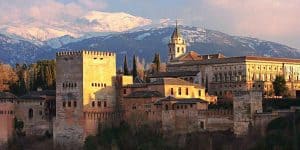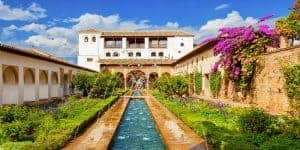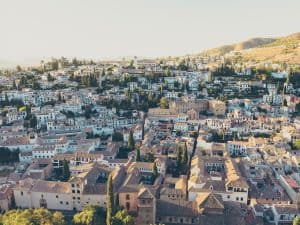Granada is located at the foot of the Sierra Nevada mountains, at the confluence of four rivers. It sits at an average elevation of 738 metres above sea level, yet is only one hour by car from the Mediterranean coast.
The name of the city means “pomegranate” in Spanish, the fruit of pomegranate is the official symbol of the city.
Granada has a vast history that goes back to prehistoric times. The region surrounding what today is Granada has been populated since at least 5500 B.C. and experienced Roman and Visigothic influences. Today the inhabitants of the city are known as granadinos.
According to the census of 2005 the population of Granada was 237 000
Granada lies on the eastern limit of the Mediterranean climate zone thus its climate is considered a hot-summer Mediterranean climate. Summers are hot and dry with daily temperatures averaging 34 °C (93 °F) in July. Winters are cool and wet, and most of the rainfall is concentrated from November through to January. The coldest month is January with daytime temperatures hovering at 13 °C (55 °F) and dropping to around 1 °C (34 °F) during the night. Frost is quite common as temperatures usually reach below-freezing in the early morning. Spring and autumn are unpredictable, with temperatures ranging from mild to warm.
The Flourishing Moorish Epoque
The Umayyad conquest of Hispania, starting in 711 A.D., brought large parts of the Iberian Peninsula under Moorish control and established Al-Andalus. The Emirate of Granada was established in 1238 following the defeat of the Almohad dynasty by an alliance of Christian kingdoms at the Battle of Las Navas de Tolosa in 1212. Following the fall of Córdoba in 1236, the city became the capital of the Emirate of Granada, and for the next 250 years Granada stood as the heart of a powerful and self-sufficient kingdom with the construction of the royal palace and fortress, the Alhambra.
The Nasrid emirs were responsible for building the Alhambra palace complex which is considered by some to be one of the 10 wonders of the world.
The Emirate of Granada provided connections with the Muslim and Arab trade centers, particularly for gold from sub-Saharan Africa and the Maghreb, and exported silk and dried fruits produced in the area. The Nasrids also supplied troops from the Emirate and mercenaries from North Africa for service to Castile.
During the Moor rule, Granada was a city with adherents to many religions and ethnicities (Arabs, Berbers, Christians, Jews) who lived in separate quarters.
Reconquista by the Christian Spanish
In the late 15th century the Christian Reconquista (or Christian reconquest) set its sights on Granada. Following a military campaign led by King Ferdinand II of Aragon and Queen Isabella I of Castile, King Boabdil of Granada was ultimately forced to surrender the town in 1492.
The Granada take over finally put an end to Moorish rule in the Iberian peninsula and marking the end of the Reconquista.
The 1492 surrender of the Islamic Emirate of Granada to the Catholic Monarchs is one of the most significant events in Granada’s history as it marks the completion of the Reconquista of Al-Andalus. The terms of the surrender, expressed in the Alhambra Decree treaty, allowed the city’s Muslim inhabitants to continue unmolested in the practice of their faith and customs, known as Mudéjar. The Alhambra Decree obliged the existing Jewish and Muslim residents to convert and began making significant changes to the appearance of the city in an attempt to hide its Muslim character, including replacing the city’s primary mosque with the massive Cathedral and constructing a large Christian palace in the heart of the Alhambra.
In 1499 Cardinal Francisco Jiménez de Cisneros undertook a program of forced Christian baptisms, creating the Converso (convert) class for Muslims and Jews. For a long time they were subject to persecution, execution, or exile, and each had cells that practiced their original religion in secrecy.
Responding to the various rebellions during 1499-1501, the Castilian Crown mandated that Granada’s Muslims must convert or leave the country. Many of the elite Muslim class subsequently emigrated to North Africa and those who stayed were to convert becoming Moriscos – the Catholics of Moorish descent.
Granada´s Links with UNESCO
Alhambra
Rising above the modern lower town, the Alhambra and the Albaycín, situated on two adjacent hills, form the medieval part of Granada. To the east of the Alhambra fortress and residence are the magnificent gardens of the Generalife, the former rural residence of the emirs who ruled this part of Spain in the 13th and 14th centuries. The residential district of the Albaycín is a rich repository of Moorish vernacular architecture, into which the traditional Andalusian architecture blends harmoniously.
The Alhambra was declared a World Heritage Site by UNESCO in 1984.
The last Moorish stronghold in Europe, the Alhambra reflects the splendour of Moorish civilisation in Andalusia and offers the best samples of ornamental architecture, spectacular and lush gardens, cascading and dripping water features, and breathtaking views of the city. If you read the Koran, it continually repeats the idea that heaven is a garden with running water. From this perspective we could say that the Alhambra is an Arabic attempt to create heaven on earth.
Nearly two million people visit the palaces each year and 8,500 people visit the Alhambra every day. It is officially recognised as Spain’s most visited monument.
The Alhambra was a palace, citadel, fortress, and the home of the Nasrid sultans, high government officials, servants of the court and elite soldiers from the 13th to the 14th century. Other notable buildings belonging to a different time period are also located within the Alhambra complex, most notably the Renaissance style Palace of Charles V, which houses the Alhambra Museum (with historical artifacts from the site) and the Fine Art Museum.
In 1828, Washington Irving, an american writer and diplomat, travelled from Madrid to Granada. At first sight, he described it as “a most picturesque and beautiful city, situated in one of the loveliest landscapes that I have ever seen.” He immediately asked the then-governor of the historic Alhambra Palace as well as the archbishop of Granada for access to the palace, which was granted because of Irving’s celebrity status. Irving was inspired by his experience to write Tales of the Alhambra. The book combines description, myth and narrations of real historical events, even up through the destruction of some of the palace’s towers by the French under Count Sebastiani in 1812, and the further damage caused by an earthquake in 1821.
The book Tales of the Alhambra was an instrument of reintroduction and promotion of the Alhambra to Western audiences.
Albayzín
Situated on a hill above the centre of town and across from the Alhambra, the Albayzín is an ancient Muslim neighbourhood popular with visitors – and rightly so. Among its narrow, winding streets one will find beautiful white-washed old buildings, splendid Arabic shops and restaurants, scenic gardens, and marvellous views of Granada and the Alhambra. Today part of a UNESCO World Heritage site (along with the nearby neighbourhood of Sacromonte), Albayzín dates back to the fourteenth century and was built as a defensive town and thrived as one of the centres of Granada under Muslim rule.
Other Places to visit in Granada
- The Cathedral of Granada is built over the Nasrid Great Mosque of Granada, in the centre of the city. Its construction began during the Spanish Renaissance in the early 16th century, shortly after the conquest of Granada by the Catholic Monarchs, who commissioned the works.
- The Royal Chapel. On September 13, 1504, the Catholic Monarchs decided they wanted their remains to be taken to Granada, and for this purpose a Royal Warrant was issued at Medina del Campo, Castile-León, for a Royal Chapel to be built. It was built between 1505 and 1517 in Isabelline Gothic style and dedicated to St. John the Baptist and St. John the Evangelist.
Granada remained a largely medieval-style city well into the 19th century, going through many economic slumps and seeing much of its architectural heritage destroyed. However, the last half of the 19th century saw Granada incorporated into the national rail network and the first stirrings of tourism thanks to reports of sites like the Alhambra to a global audience.
- San Nicolas Viewpoint (Mirador de San Nicolas). The most popular attraction in the Albayzin for tourists, this spot offers a spectacular view of the Alhambra and the mountains behind, as well as spectacular views of the city and up the Rio Darro canyon.
- Sacromonte is a traditional neighborhood of the Granadian Gipsies (Roma) situated at the east of the Albayzin. It is one of the most picturesque neighbourhoods of the city, by the landscape and its cave houses, installed in whitewashed caves that serve as housing, where they perform a traditional dances of flamenco, which became one of the tourist reclamations most renowned of Granada.
- Granadian Carmens. Nothing to do with Bizet´s opera, these are hillside townhouses with private walled gardens. They originate from Moorish times, and the design of the carmen expresses the Islamic idea of the inner paradise, a reflection of heaven. The Albaicin in Granada has many carmens, with a few open to visitors, such as the Carmen de la Victoria, on Cuesta del Chapiz. Its delightful multi-level garden features pebble mosaic floors, shady grottos and lush flora.
- Baths. Visiting the ´´hammam´´ or public bathhouse was an essential pastime, both for hygiene and social reasons, in Moorish Granada – they were important meeting places for both sexes (on separate days), as well as having religious significance. Originally there were literally hundreds of public baths in the city, and one of the few remaining complete examples is El Bañuelo on Carrera del Darro, which dates from 11th century. It consists of a series of perfectly preserved brick-vaulted chambers with typical horseshoe-shaped arches, used as cool, warm and hot rooms, with pretty, star-shaped skylights which let light in, and steam out.




